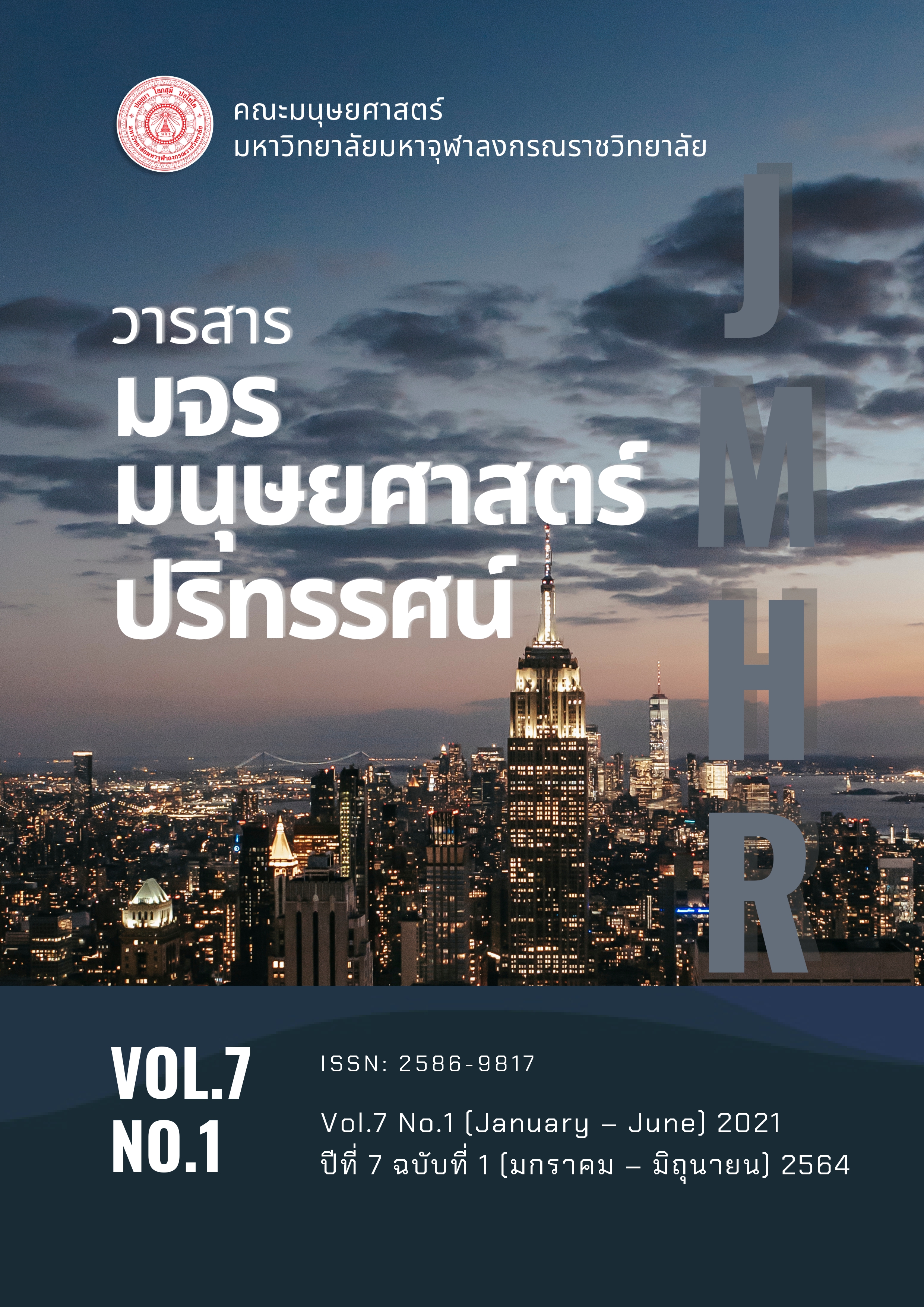นวัตกรรมการไกล่เกลี่ยของผู้ประนีประนอมในศาลยุติธรรมตามแนวพุทธจิตวิทยา
คำสำคัญ:
นวัตกรรม, การไกล่เกลี่ยน, ผู้ประนีประนอม, พุทธจิตวิทยาบทคัดย่อ
การศึกษาวิจัยเรื่อง นวัตกรรมการไกล่เกลี่ยของผู้ประนีประนอมในศาลยุติธรรม ตามแนวพุทธจิตวิทยา มีวัตถุประสงค์เพื่อศึกษา เพื่อวิเคราะห์รูปแบบไกล่เกลี่ยความขัดแย้งในปัจจุบัน ศึกษาหลักพุทธธรรมและหลักจิตวิทยาเพื่อการไกล่เกลี่ย และเพื่อนำเสนอนวัตกรรมการไกล่เกลี่ยฯ แนวพุทธจิตวิทยา การศึกษาในครั้งนี้ เป็นรูปแบบการวิจัยเชิงคุณภาพ (Qualitative research) แบบลงภาคสนาม โดยการสัมภาษณ์เชิงลึก (In-depth interview) กลุ่มผู้ให้ข้อมูลสำคัญ (Key Informants) กลุ่มผู้เชี่ยวชาญการไกล่เกลี่ยในศาลยุติธรรม นักวิชาการด้านพระพุทธศาสนา และนักวิชาการด้านจิตวิทยา รวมจำนวน 17 ท่าน ลงพื้นที่เก็บข้อมูล ณ ศาลยุติธรรมภาค 1 โดยจะใช้ระยะเวลา 12 เดือนในการศึกษา (มกราคม – ธันวาคม พ.ศ.2563) การวิเคราะห์ข้อมูลใช้วิธีการวิเคราะห์เนื้อหา ทั้งหมดโดยใช้เทคนิค QDAT Knowledge : 6’C เพื่อนำข้อมูลที่ได้มาประกอบกับข้อมูลเชิงเอกสารที่วิเคราะห์ไว้ เพื่อหาข้อสรุปหรือคำอธิบายเชิงทฤษฎีจากลักษณะหรือบริบทโดยทั่วไป ไปสู่ข้อสรุปเกี่ยวกับปรากฏการณ์นั้น ๆ ในเชิงพรรณนา ผลการวิจัย ค้นพบกลวิธีและเทคนิคการไกล่เกลี่ยของผู้ประนีประนอมในศาลยุติธรรม ตามแนวพุทธจิตวิทยา ประกอบด้วย 9 เทคนิควิธี ได้แก่ 1. สัมมาสติ 2. ทำหน้าที่กัลยาณมิตร 3. ฟังอย่างลึกซึ้ง 4. วิเคราะห์ปัญหา 5. ความคิดเชิงบวก 6. คิดอย่างแยบคาย 7. หาความต้องการแท้จริง 8. เสนอทางเลือก และ 9. สร้างความสัมพันธ์ใหม่ ทุกขั้นตอนมีความสำคัญมากต่อผู้ประนีประนอมเองและคู่พิพาท ซึ่งจะต้องมีบทบาทหน้าที่ร่วมมือกัน เพื่อให้บรรลุเป้าหมายในการหาแนวทางยุติความขัดแย้ง ส่งเสริมความเข้าใจและสร้างสัมพันธภาพที่ดีร่วมกัน
การแก้ไขปัญหาความขัดแย้งมีความละเอียดอ่อนและลึกซึ้งในหลายแง่มุมและวิธีการ งานวิจัยนี้เป็นการศึกษาและนำเสนอรูปแบบการแก้ไขความขัดแย้งของผู้วิจัย หากนำรูปแบบดังกล่าวนี้ไปประยุกต์ใช้ในกระบวนการไกล่เกลี่ย โดยจัดอบรมเชิงปฏิบัติการให้กับองค์กรหรือหน่วยงาน กลุ่มเป้าหมาย จะเป็นรูปแบบที่สามารถนำมาจัดการกับปัญหาความขัดแย้งได้อย่างมีประสิทธิภาพและประสิทธิผล และประยุกต์ใช้ในกระบวนการไกล่เกลี่ยได้จริง
เอกสารอ้างอิง
ชลากร เทียนส่องใจ. (2539). การเจรจาไกล่เกลี่ยคนกลางเชิงพุทธ : หลักการและเครื่องมือสำหรับจัดการความขัดแย้ง (วิทยานิพนธ์พุทธศาสตรดุษฎีบัณฑิต, บัณฑิตวิทยาลัย). มหาวิทยาลัยมหาจุฬาลงกรณราชวิทยาลัย. พระนครศรีอยุธยา.
ชัยวัฒน์ สถาอานันท์, (2539). สันติทฤษฎี/วิถีวัฒนธรรม. กรุงเทพมหานคร: เรือนแก้วการพิมพ์.
นภัทร์ แก้วนาค, (2555). เอกสาร ประกอบการสอน เรื่อง เทคนิคการวิเคราะห์ ข้อมูลเชิงคุณภาพ (Qualitative Data Analysis Technic) (QDAT Knowledge). หลักสตูรดุษฎีบัณฑิต. มศว. ประสานมิตร.
เบอร์นาร์ด เมเยอร์, (2553). พลวัตการจัดการความขัดแย้ง (บรรพต ต้นธีรวงศ์, ผู้แปล). กรุงเทพมหานคร: คบไฟ.
ปรัชญา อยู่ประเสริฐ, (2550). ขั้นตอนกระบวนการไกล่เกลี่ยข้อพิพาท, ในรวมบทความเทคนิคจิตวิทยาและการสื่อสารสำหรับการไกล่เกลี่ยข้อพิพาท. กรุงเทพมหานคร: บริษัท ธนาเพรส จำกัด.
พระธรรมปิฏก (ป.อ.ปยุตฺโต), (2538). การศึกษาเพื่อสันติภาพ. กรุงเทพฯ: มูลนิธิพุทธรรม.
พระมหาศิวะเสน ญาณเมธี. (2561). รูปแบบการบริหารจัดการความขัดแย้งในพระพุทธศาสนา วิเคราะห์จากพระไตรปิฎก (ปรัชญาดุษฎีบัณฑิตบริหารการศึกษาบัณฑิตวิทยาลัย). มหาวิทยาลัยสยาม. กรุงเทพฯ.
พระมหาหรรษา ธมฺมหาโส. (2554). พุทธสันติวิธี การบูรณาการหลักการและเครื่องมือจัดการความขัดแย้ง (พิมพ์ครั้งที่ 1). กรุงเทพมหานคร: บริษัท 21 เซ็นจูรี่ จำกัด.
พิเชษฐ์ คงศิลา และคณะ. (2562). บทบาทสำนักระงับข้อพิพาทกับการพัฒนาการไกล่เกลี่ยข้อพิพาทในศาลยุติธรรม. สืบค้น 26 พฤศจิกายน 2562, จาก http://elib.coj.go.th/Article/J5
พีรภาส วิบูลย์วัฒนกิจ. (2559). รูปแบบการใช้หลักจริต 6 เพื่อการไกล่เกลี่ยของผู้ประนีประนอมในศาลยุติธรรม (วิทยานิพนธ์ปริญญามหาบัณฑิต). มหาวิทยาลัยมหาจุฬาลงกรณราชวิทยาลัย. พระนครศรีอยุธยา.
ศาลยุติธรรม. (2562). รายงานสถิติคดีของศาลทั่วราชอาณาจักร. สืบค้น 26 พฤศจิกายน 2562, จาก https://www.coj.go.th/th/page/item/index/id/2
อัครศักดิ์ จิตธรรมมา, (2555). การพัฒนาระบบไกล่เกลี่ยข้อพิพาทในศาลยุติธรรม. กรุงเทพมหานคร : สำนักส่งเสริมงานตุลาการ สำนักงานยุติธรรม.






